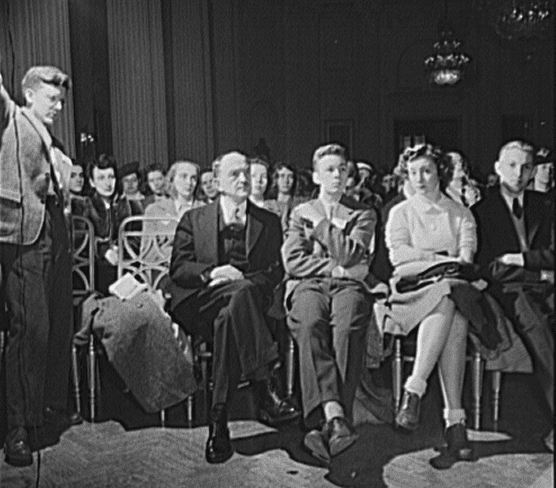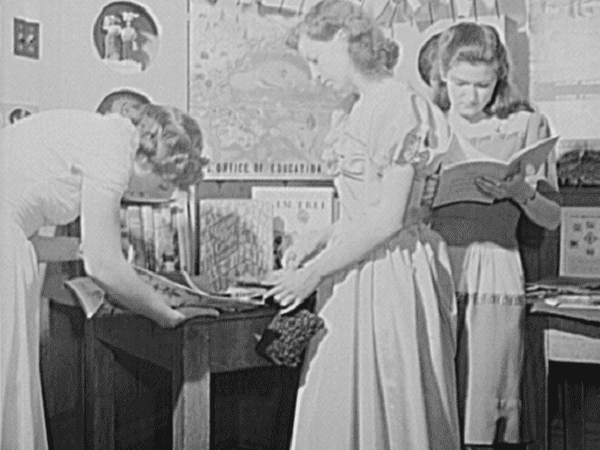Introduction: In this article, Gena Philibert-Ortega searches old newspapers to learn more about high school dress codes from the past. Gena is a genealogist and author of the book “From the Family Kitchen.”
It’s time to go back to school! Most students across the United States have either started the school year or will shortly. The lazy, carefree days of summer have evolved into that time of the year when rules and order reign supreme (or at least that’s the hope). By the time a student reaches the high school classroom, rules regarding conduct have become second nature, including the high school dress code.

My youngest is now a senior in high school and his school’s dress code has, in the past, been criticized nationally for its treatment of female students. However, this year the dress code has become more relaxed in dictating what students are allowed and not allowed to wear. Dress codes and criticisms of those codes by students, teachers, and parents are decades old. In researching those codes, it becomes apparent that some rules, like the length of a girl’s skirt, remain consistent while others, like the length of a boy’s hair, might be in response to the fashion trends of a generation.
Girls’ Dress Code: Skirts vs Pants
One prominent theme in dress codes for female students up until the 1970s (and sometimes even later depending on the school) was the prohibition against wearing pants. Judging from the comments I received from Facebook friends on this topic, female students were required to wear skirts or dresses well into the 1970s. And the appropriate length – at the knees – was judged by having the girl kneel so that her skirt would hit the floor. Girls were required to wear skirts at school no matter how cold the weather was.
The penalty for not obeying the dress code? Depending on the school it could be either sending the student home to change, detention, or suspension – as one Facebook friend was when she wore a polyester pantsuit that looked a little too much like denim, resulting in a two-day suspension in the mid-1970s. Even when female students could finally wear pants at school, they were not free to choose any pair of pants. For many it had to be a coordinated pantsuit and absolutely not denim jeans.
Did anyone ever publicly protest their school dress code? No doubt some students did. There was one case in 1942 when Abraham Lincoln High School (Brooklyn, New York) student Beverly Bernstein protested her school’s dress code by wearing slacks and a sweater to school one day. She was promptly suspended, which resulted in other girls carrying on with the protest the next day and wearing slacks in solidarity.
Cartoonist Russ Westover of “Tillie the Toiler” fame weighed in with his opinions about women wearing slacks, and mentioned Beverly’s case. According to his article the girls had put together a petition for school authorities that cited the government’s advocating for wearing slacks in the “event of an air raid” and that wearing slacks “conserved silk stockings,” which reflected the WWII-era they were living in.
Skirt lengths have always been an issue addressed in dress codes. While it follows that short skirts would largely be frowned upon, I was surprised when Facebook friends told me that they were sent home in the 1960s and 1970s for skirts that reached their ankles!
The reason might be found in this newspaper article from 1965. A principal justified sending two girls home for wearing ankle-length dresses because: “The attire worn by a student must not be unorthodox in such a manner as to be a distracting or disturbing factor in the instruction program.” Apparently, some schools believed that long skirts were just as distracting as short ones.
Boys’ Dress Code: Ties and Haircuts
Boys’ dress codes were also controversial in decades past. While jeans and t-shirts are the norm today, in 1958 the dress code in Livingston, New Jersey, required boys to wear “dress shirts unbuttoned at the neck or wear ties when the shirts are buttoned all the way.” It seems the kids at that high school were not happy about the new dress code; 13 had already been suspended for protesting it in less than a week. A friend from Kansas told me that his school in the 1960s required the same standard of dress as above, but the shirt had to be tucked in and a belt worn at all times. Dressing casually was not an option when one went to school.
One of the concerns addressed in boys’ dress codes was the length and style of their hair, as in the case of the following 1972 announcement from Fort Worth, Texas, that stated boys’ hair: “Must be above the eyebrows in front, be kept trim and neat and that sideburns cannot come below the bottom of the ear.” This had been changed from the previous rule that “boys’ hair could not come below the top of the collar in the back.” There’s no doubt that this most likely became an issue as men’s hairstyles followed trends found in the music world of the 1960s and 1970s.
Now It’s Your Turn
What was the dress code when you were a teenager? How has it changed from that time to today? What dress code do your kids or grandkids have to follow? Did you rebel against the dress code?
Note: Special thanks to my Facebook friends who shared their stories with me about their high school dress codes. There are too many to name individually but their stories helped me with the research for this article.
